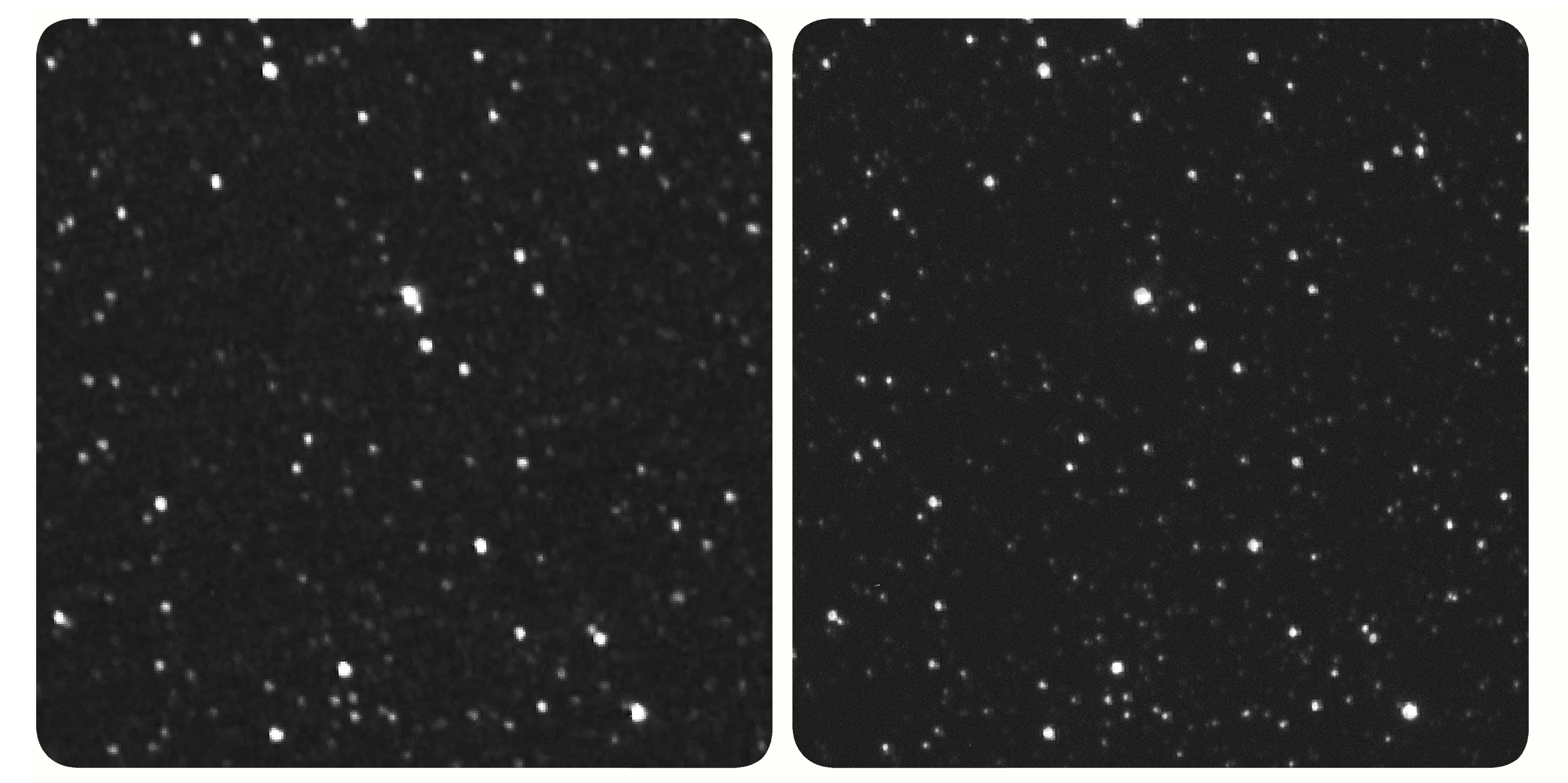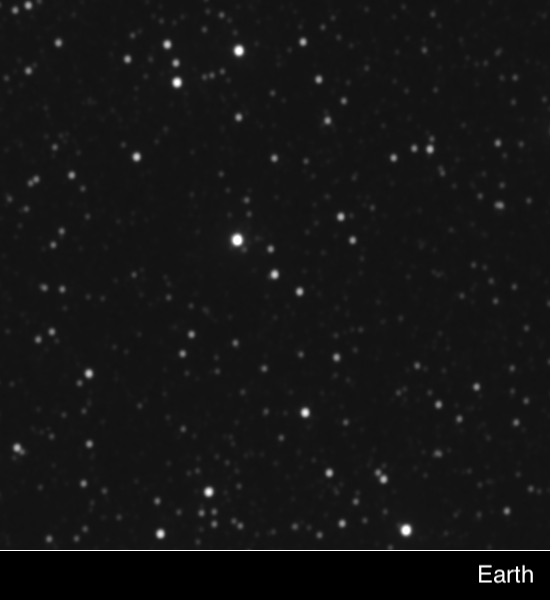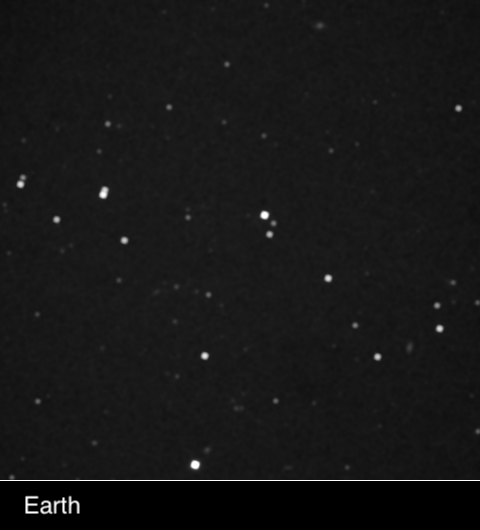
NASA's pioneering New Horizons spacecraft has traveled so far that its view of the cosmos is noticeably different than ours.
New Horizons, which flew by Pluto in 2015 and the even more distant object Arrokoth last year, recently photographed the nearby stars Proxima Centauri and Wolf 359. In a spacecraft first, the imagery shows the two stars occupying slightly different patches of sky than they do from our perspective here on Earth.
"It's fair to say that New Horizons is looking at an alien sky, unlike what we see from Earth," New Horizons principal investigator Alan Stern, of the Southwest Research Institute (SwRI) in Boulder, Colorado, said in a statement. "And that has allowed us to do something that had never been accomplished before — to see the nearest stars visibly displaced on the sky from the positions we see them on Earth."
Related: Destination Pluto: NASA's New Horizons mission in pictures

New Horizons captured the imagery on April 22 and April 23, when the probe was more than 4.3 billion miles (6.9 billion kilometers) from its home planet. That's so far away that it took 6.5 hours for the data containing the photos, moving at the speed of light, to travel from New Horizons to mission scientists' inboxes. (New Horizons isn't the farthest-flung spacecraft, however. For instance, NASA's Voyager 1 and Voyager 2 probes are both exploring interstellar space, more than 11 billion miles from home.)
Proxima Centauri and Wolf 359 are much more distant still, of course. Though Proxima Centauri is the sun's nearest neighbor, the red dwarf star is still 4.2 light-years — about 25 trillion miles (40 trillion km) — from Earth. Wolf 359 lies about 7.9 light-years from us.
New Horizons team members compared the probe's photos to imagery of Proxima Centauri and Wolf 359 captured by two ground-based telescopes — one at Siding Spring Observatory in Australia and another at Mt. Lemmon Observatory in Arizona.
Get the Space.com Newsletter
Breaking space news, the latest updates on rocket launches, skywatching events and more!

Both Proxima Centauri and Wolf 359 appear to jump when the two photo sets are overlaid, showcasing the "parallax effect." (You can witness this effect firsthand, by the way: Hold your index finger up at arm's length, then blink each eye successively as you stare at it.)
"The professional and amateur astronomy communities had been waiting to try this, and were very excited to make a little space exploration history," New Horizons science team member Tod Lauer, of the National Science Foundation's National Optical-Infrared Astronomy Research Laboratory, said in the same statement. "The images collected on Earth when New Horizons was observing Proxima Centauri and Wolf 359 really exceeded my expectations."
Lauer coordinated the parallax demonstration and created the new double-barreled imagery, which includes 3D views of the stars from the different perspectives. In this latter effort he had help from New Horizons deputy project scientist John Spencer of SwRI and science team collaborator Brian May, an astrophysicist who also happens to play guitar for the band Queen.
"It could be argued that in astro-stereoscopy — 3D images of astronomical objects — NASA’s New Horizons team already leads the field, having delivered astounding stereoscopic images of both Pluto and the remote Kuiper Belt object Arrokoth,” May said in the same statement.
"But the latest New Horizons stereoscopic experiment breaks all records," May added. "These photographs of Proxima Centauri and Wolf 359 — stars that are well-known to amateur astronomers and science fiction aficionados alike — employ the largest distance between viewpoints ever achieved in 180 years of stereoscopy!"
You can learn more about the experiment today (June 12): Stern, May and two other New Horizons scientists will participate in a Reddit "Ask Me Anything" session at 1 p.m. EDT (1700 GMT).
The parallax demonstration was not done for scientific purposes, Stern told Space.com (though he did note that the New Horizons imagery might find its way into textbooks that discuss the parallax effect). Rather, the main goal was public outreach and engagement, and a desire to provide us all with some cosmic poetry and perspective.
We could get more such demonstrations, and much more data, from New Horizons in the coming years. The probe remains in good health and has enough fuel to fly by yet another object in the 2020s, if a suitable target can be found and NASA approves another mission extension, Stern and other team members have said.
- New Horizons' historic flyby of Arrokoth: Full coverage
- Pluto flyby anniversary: The most amazing photos from NASA's New Horizons
- New Horizons may make yet another flyby after Arrokoth
Mike Wall is the author of "Out There" (Grand Central Publishing, 2018; illustrated by Karl Tate), a book about the search for alien life. Follow him on Twitter @michaeldwall. Follow us on Twitter @Spacedotcom or Facebook.
OFFER: Save 45% on 'All About Space' 'How it Works' and 'All About History'!
For a limited time, you can take out a digital subscription to any of our best-selling science magazines for just $2.38 per month, or 45% off the standard price for the first three months.
Join our Space Forums to keep talking space on the latest missions, night sky and more! And if you have a news tip, correction or comment, let us know at: community@space.com.

Michael Wall is a Senior Space Writer with Space.com and joined the team in 2010. He primarily covers exoplanets, spaceflight and military space, but has been known to dabble in the space art beat. His book about the search for alien life, "Out There," was published on Nov. 13, 2018. Before becoming a science writer, Michael worked as a herpetologist and wildlife biologist. He has a Ph.D. in evolutionary biology from the University of Sydney, Australia, a bachelor's degree from the University of Arizona, and a graduate certificate in science writing from the University of California, Santa Cruz. To find out what his latest project is, you can follow Michael on Twitter.
-
JPL-ACE I wonder if this new view can improve the distance measurement any. This is a pretty good base line but the pointing accuracy and resolution are toy like compared to present telescopes. Present base lines are the orbit of Earth.Reply -
rod Yes, I am waiting to see the published parallax obtained using the Earth and New Horizons location, i.e. the new and improved baseline with parallax.Reply










